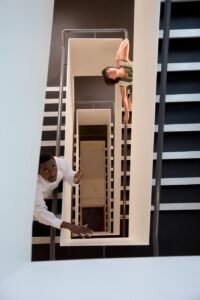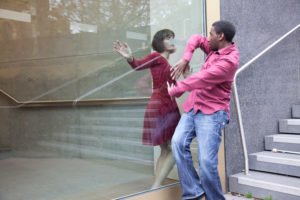Isabel Jones March 2025
Salamanda Tandem is dedicated to an inclusive and various sensory art that supports the realisation of well being and potential. Aiming to nurture and celebrate the deepest resources of human creativity.
Founded in 1989, upon a series of values and principles that set out to remove discrimination in the arts, a substantial body of work, and publishing in education and training show how to create inclusion in practice. Salamanda Tandem are international pioneers in the fields of Disability arts, socially engaged performance and community music and dance.


In 2000, Salamanda Tandem became a registered Charity, that is still active today.
The climate is ever changing, and our creative processes are being applied now to work on attitudinal change in the well being, fitness and yoga industry’s. There are huge problems with the exclusion of Disabled people there. Similar to what we found in the arts: a lot is happening out there, but very little that is accessible or friendly. One of the key barriers, are the physical movement systems, that privilege certain body types, and the prevalent style of fitness & yoga teaching from the front, which excludes all VI people immediately.
Why we think it matters
Beginning with Isabel’s father Lewis Jones, who developed a unique culture, within our family, and with his two brothers, Griff Jones and William Jones known as Bill. All three were Blind from birth and became Deafblind in early adulthood, due to a hereditary condition called Norris disease, that still continues today. When they were young children, Lewis, Bill and Griff, were placed in institutions, the only route to education at that time for Disabled children. We know from Lewis’s experience, that from Day 1, he entered a frightening world of discrimination, isolated from his home and parents. His Welsh culture and language and his disability were multiple sources for bullying and discrimination in those schools. The effects of this discrimination on him and on 3 subsequent generations has been profound.
Our parents set out to politicise us, see that with disability meant poverty, health problems, and exclusion and this was unfair. Our parents, grew a counter culture, both energetic and dynamic that was very particular to the unique imagination of my father, and a high level of attunement to his inner world. The daily stuff of life was in essence a side show, to the primary idea, of ‘celebrating and being proud of difference’.
As a parent, Lewis taught me to think differently, first in early childhood through simple questions and games, like ‘the 2 identical stones’, and later on through thought processes rooted in meditation, mantra and pranayama. His mind worked differently to anyone else I have ever known and mine grew differently too. In Dec 2014 I met Prashant Iyengar in Pune India, shortly after Lewis died. I had been concerned with the question, should I continue the study and become a senior teacher, given the kind of physical practice expected at that level was not accessible to Lewis. With a big question in my mind: I asked Prashant, was Lewis doing yoga, despite the fact that he couldn’t do the physical poses? His answer was “yes” there are people in the world who are more enlightened, you father was one of those” ‘he was your guru”
Lewis cultivated the magic of inner awareness, and knew so much, yet how and why was there such cruel discrimination towards him, all for no good reason, the world was unfair I saw that by the age of 3, and how it carried on through every aspect of our family life.
Lewis was a thought leader in creativity, and this extra-ordinary spark for change, created the catalyst for Salamanda Tandem, and a new sensory art form and a community of artists led by the unique culture and creativity of visually impaired, blind, and deafblind people, that could change the limited perceptions of sighted people, via artistic collaboration, to expand, and become politicised so there are no barriers to inclusion.
We grew up organically to be the engineers of participation, and developers of socially engaged performance, committed to the realisation of wellbeing in self and others.
In the first years of Salamanda Tandem, the work could not be conducted in arts, culture, heritage or education buildings, as these were places where disabled people, and seldom heard carers with their loved could not gracefully go. We have knocked on many closed doors, worked in available corridors, lifts, platforms, cupboards, and taped off many a staircase, but the body of our work was grown and devised in institutions, as well as outdoors and in buildings of other kinds – our aim is to in which people can find a place on their own terms.
A huge part of our work has been dedicated to institutional change in the UK: where it was normal for disabled people to be incarcerated, and humiliated with policies like behaviour modification, normalisation, cruel methods and medical practices. This led us into professional education, the training of artists, arts organisations, health care professionals, and into the publication & documentation of our methods and practice. The problems of access, go beyond the physical environment, and education remains paramount to make our unconscious negative biases, conscious, so that we can take judicious and proper action to remove discrimination.
Responding to ever changing environments, there is always a sense of urgency driven by social justice underpinning our work and new sectors where little has been done.
Positive change has happened, and the Equality Act of 2010 now makes discrimination illegal in the UK. However, we see in the effects of war, how disparity occurs immediately. When a building is bombed, what happens then to a disabled person’s hard won mobility, communication and access aids? the long cane, the hearing aid, the wheelchair, all destroyed – no access to a shelter. Across the world, we saw how the Pandemic and its aftermath created huge inequality. Here at home, on top of years of austerity, the immediate closure of arts, education and community buildings, the subsequent loss of infrastructure, and permanent loss of childcare, healthcare services. The socioeconomic inequity, where people’s basic care needs, housing and health are neglected, meant that arts work with people is barely alive.

